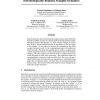Free Online Productivity Tools
i2Speak
i2Symbol
i2OCR
iTex2Img
iWeb2Print
iWeb2Shot
i2Type
iPdf2Split
iPdf2Merge
i2Bopomofo
i2Arabic
i2Style
i2Image
i2PDF
iLatex2Rtf
Sci2ools
93
Voted
NIPS
2000
2000
Processing of Time Series by Neural Circuits with Biologically Realistic Synaptic Dynamics
Experimental data show that biological synapses behave quite differently from the symbolic synapses in common artificial neural network models. Biological synapses are dynamic, i.e., their "weight" changes on a short time scale by several hundred percent in dependence of the past input to the synapse. In this article we explore the consequences that these synaptic dynamics entail for the computational power of feedforward neural networks. We show that gradient descent suffices to approximate a given (quadratic) filter by a rather small neural system with dynamic synapses. We also compare our network model to artificial neural networks designed for time series processing. Our numerical results are complemented by theoretical analysis which show that even with just a single hidden layer such networks can approximate a surprisingly large large class of nonlinear filters: all filters that can be characterized by Volterra series. This result is robust with regard to various chang...
Related Content
| Added | 01 Nov 2010 |
| Updated | 01 Nov 2010 |
| Type | Conference |
| Year | 2000 |
| Where | NIPS |
| Authors | Thomas Natschläger, Wolfgang Maass, Eduardo D. Sontag, Anthony M. Zador |
Comments (0)

